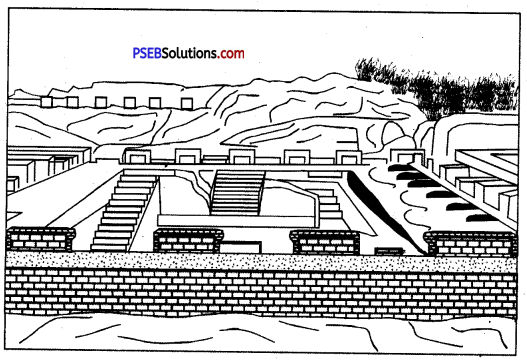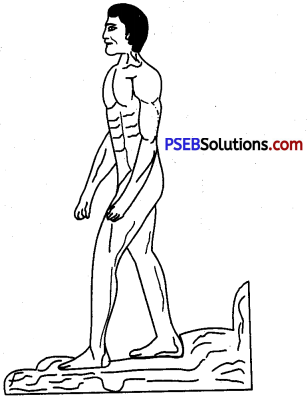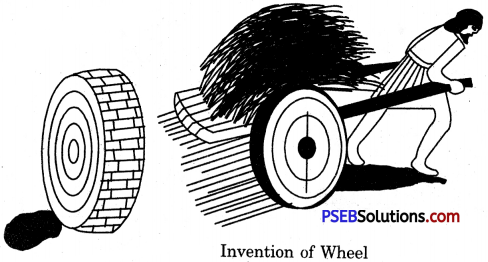Punjab State Board PSEB 6th Class Social Science Book Solutions Civics Chapter 21 Urban Development – Local Self Government Textbook Exercise Questions and Answers.
PSEB Solutions for Class 6 Social Science Civics Chapter 21 Urban Development – Local Self Government
SST Guide for Class 6 PSEB Rural Development and Local Self Government Textbook Questions and Answers
I. Answer the following questions in brief :
Question 1.
Write a short note on urban development after Independence.
Answer:
After India’s Independence in 1947, urban areas in the country were developed at a fast pace, due to an increase in population. There was a shortage of agricultural land due to the increase in population in rural areas. Consequently, the villagers began to move cities for seeking employment. Besides, the lack of amenities like education and health also compelled the village people to go to urban areas. Modern means of transport and communication have also acted as a bridge between villages and cities. As a result, the village population in India has come down from 90% to 75%.
Due to the fast increasing population in urban areas, cities require more houses, much electricity, much clean drinking water, more means of transport, cleanliness, and disposal of garbage. So special attention is paid to urban development. This is the reason why there is an increase in the number of urban local institutions, viz., Nagar Panchayats, Municipal Committees and Municipal Corporations in India.
Question 2.
Name the urban Local Self-Institutions.
Answer:
There are three urban local self-institutions.
They are :
- Nagar Panchayat,
- Municipal Committee (Council)
- Municipal Corporation.
Question 3.
Why is city divided into wards on the basis of population?
Answer:
Number of members of urban local institutions is fixed on the basis of population. Therefore, the whole city is divided, on the basis of almost equal population, into wards and one member is elected from each ward.
Question 4.
What age is required for the candidate to be a councillor?
Answer:
The age of 21 years is required for the candidate to be a councillor.
![]()
Question 5.
What is town’s Local Self-Institution known as?
Answer:
Local self-institution in a town is known as Nagar Panchayat or Nagar Council.
Question 6.
Name four officials of Municipal Corporation.
Answer:
Four officials of Municipal Corporation are Commissioner, Health Officer, Education Officer and Chief Engineer.
Question 5.
Name any two sources of income of (urban) Local Self-Government.
Answer:
Taxes, fees, government grants and loans are the four sources of income of (urban) local self-government.
Question 6.
What are your duties towards city Local Self-Government?
Answer:
Our duties towards city local self-government are as follows:
- We should help the local self-government of our city in its functioning.
- We should make a proper use of the facilities like electricity and drinking water, provided by it.
- We should help it in keeping the city clean. We should not spread rubbish in the city.
- We should keep the environment neat and clean and also protect it.
Question 7.
Give two functions of Municipal Cpuncil or Corporation.
Answer:
The following are two functions of Municipal Council or Corporation :
1. Compulsory Functions.
- It sets up local hospitals and dispensaries.
- It immunizes.children against smallpox, polio, tuberculosis, cholera, diptheria, etc.
- It takes care of sanitation and cleanliness of the city. It maintains sewage system and removes rubbish and garbage.
- It provides good roads and streets in its area and maintains them in good condition.
- It provides primary schools and opens libraries, reading rooms, museums and adult education centres, etc.
- It provides safety against fire.
2. Optional Functions:
- It develops parks, gardens and playgrounds, etc.
- It provides cheap and efficient bus service.
- It maintains rest houses, children homes and senior citizen homes, etc.
![]()
Question 8.
Give two functions of District Administration.
Answer:
Two functions of District Administration are given below :
- It maintains law and order in the district with help of the police.
- It maintains all the land records in the district and collects land revenue from the farmers.
II. Fill in the blanks :
Question 1.
Nagar Panchayat is set in a _______
Answer:
town
Question 2.
Urban local self-government functions are looked after by _______
Answer:
the State Government
Question 3.
To be a councillor, the candidate should be of _______ years of age.
Answer:
21, 18
Question 4.
In each district, there are _______ types of courts.
Answer:
two
![]()
Question 5.
An area changing from village to town is known as _______
Answer:
transitional area.
III. Write ‘true’ or ‘false’ in the brackets given after each statement :
Question 1.
A foreigner can cast his vote in the election of Municipal Corporation of your city.
Answer:
False
Question 2.
There are 9 Municipal Corporations in Punjab.
Answer:
True
Question 3.
The President of the Municipal Corporation is known as Mayor in Punjab.
Answer:
False
Question 4.
The voter should be of 17 years for the election of local government.
Answer:
False
Question 5.
Deputy Commissioner is the Chief Government official of the District Administration.
Answer:
False
![]()
Question 6.
There ard district level officials of various departments to run the District Administration.
Answer:
True
IV. Multiple Choice Questions :
Question 1.
Which is the primary unit of local urban self¬government?
(a) Nagar Nigam
(b) Village Panchayat
(c) Nagar Panchayat.
Answer:
(c) Nagar Panchayat.
Question 2.
Which name is given to the head of a Municipal Corporation (Nagar Nigam)?
(a) Pradhan
(b) Mayor
(c) Sarpanch.
Answer:
(b) Mayor.
Question 3.
Who is the executive officer of Municipal Corporation?
(a) Superintendent
(b) Deputy Commissioner
(c) Commissioner.
Answer:
(c) Commissioner.
Question 4.
Which of the following cities does not have Municipal Corporation?
(a) Amritsar
(b) Patiala
(c) Ropar
(d) Ludhiana
(e) Bathinda
(f) Jalandhar
Answer:
(c) Ropar.
Question 5.
Which is the highest administrative officer of a district?
(a) D.E.O
(b) Police Commissioner
(c) D.P.R.O.
(d) Deputy Commissioner.
Answer:
(d) Deputy Commissioner.
![]()
Question 6.
In big cities where the road is overcrowded, to reduce its crowd a road is built up over it. Which name is given to this over built up road?
(a) cycle rickshaw track
(b) underground subway
(c) link road
(d) fly over.
Answer:
(d) fly over.
PSEB 6th Class Social Science Guide Urban Development – Local Self Government Important Questions and Answers
Multiple Choice Questions:
Question 1.
Which of these is a part of Local Self-government for urban areas?
(A) Nagar Panchayat
(B) Municipalities
(C) Municipal Corporation
(D) All of these.
Answer:
(D) All of these.
Question 2.
Municipal Councils are generally set up in those cities whose population is more than
(A) 5,000
(B) 20,000
(C) 50,000
(D) 1,00,000.
Answer:
(B) 20,000.
Question 3.
_______ are established in big cities.
(A) Municipal Councils
(B) Zila Parishads
(C) Nagar Panchayats
(D) Municipal Corporations.
Answer:
(D) Municipal Corporations.
![]()
Question 4.
Elected representative of award is known as
(A) M.L.A.
(B) M.P.
(C) Ward Councillor
(D) None of these.
Answer:
(C) Ward Councillor.
Question 5.
Which of these is the function of Municipal Corporation?
(A) Supply of water
(B) Scavenging and removal of waste
(C) Supply of electricity
(D) All of these.
Answer:
(D) All of these.
Question 6.
Which of these is the source of income for Municipal Corporation?
(A) Property tax
(B) Water and other services tax
(C) Entertainment tax
(D) All of these.
Answer:
(D) All of these.
Question 7.
Who listens to the problems of local level?
(A) M.L.A.
(B) Ward Councillor
(C) M.P.
(D) D.C.
Answer:
(B) Ward Councillor.
Question 8.
Which of these cities have Municipal Corporation?
(A) Delhi
(B) Mumbai
(C) Kolkata
(D) All of these.
Answer:
(D) All of these.
![]()
Question 9.
Which of these cities don’t have Municipal Corporation?
(A) Chandigarh
(B) Chennai
(C) Meerut
(D) Lucknow.
Answer:
(C) Meerut.
Very Short Answer Type Questions
Question 1.
Who presides over the meetings of the Municipal Corporation?
Answer:
Mayor.
Question 2.
Who is Municipal Commissioner?
Answer:
Municipal Commissioner is a senior government employee who looks after the works of Municipal Corporation.
Question 3.
Give one point of difference between a Municipal Committee and a Municipal Corporation.
Answer:
A Municipal Committee is formed in a small city, while a Municipal Corporation is formed in a big city.
Question 4.
How is the number of members in a Nagar Panchayat or Municipal Committee or Municipal Corporation determined?
Answer:
The number of members in a Nagar Panchayat or Municipal Committee or Municipal Corporation is determined on the basis of population of the city.
Question 5.
How is the Mayor elected?
Answer:
The Mayor is elected by the members of Municipal Corporation amongst themselves.
Question 6.
What is the major function of the District Administration?
Answer:
The major function of the District Administration is to maintain law and order in the district.
![]()
Question 7.
Under whose charge are the health services in the district?
Answer:
The health services in the district are under the charge of the District Civil Surgeon.
Question 8.
Which is the Highest court in the district?
Answer:
The highest court in the district is the Court of the Sessions Judge.
Question 9.
Who is the highest police officer in the district?
Answer:
The highest police officer in the district is the Police Commissoner.
Question 10.
What are the main types of litigations?
Answer:
There are two types of litigations. These are civil litigations and criminal litigations.
Question 11.
When and where was the first Municipal Corporation established in India?
Answer:
In India, the first Municipal Corporation was established in 1987 A.D. in Chennai.
Question 12.
What are two sources of income of Nagar Panchayats?
Answer:
Two sources of income of Nagar Panchayats are :
- Grants from the State Government.
- Income from taxes like house tax, building tax, sales tax and vehicle tax, etc.
Question 13.
Name the cities of Punjab where Municipal Corporations are working.
Answer:
Amritsar, Jalandhar, Ludhiana, Patiala and Bathinda.
![]()
Question 14.
How many Municipal Corporations are there in India?
Answer:
There are nearly 125 Municipal Corporations in India.
Question 15.
Into how many districts has Punjab been divided?
Answer:
Punjab has been divided into 20 districts.
Question 16.
Name the three levels at which the District Administration works.
Answer:
- District level,
- Tehsil/Block level,
- City/Town/Village level.
Question 17.
What is meant by Nagar Panchayat?
Answer:
The local self-government which is formed in a town with a population of not more than 20,000 is known as Nagar Panchayat.
Question 18.
What is Municipal Corporation?
Answer:
It is the highest institution of urban local self-government and is established in a large city with population in lacs.
Question 19.
Who is a Councillor?
Answer:
Councillor a member of Municipal Council, Committee or a Corporation. He is elected at local level.
Short Answer Type Questions
Question 1.
Which are the local bodies working in urban areas?
Answer:
Nagar Panchayat, Municipal Committee (Council) and Municipal Corporation are the local bodies working in urban areas.
- Nagar Panch&yat: It works in a town where the population is not more than 20,000.
- Municipal Committee (Council): It works in a city where the population is between 20,000 and one lac.
- Municipal Corporation: It works in a city with a population of over one lac.
![]()
Question 2.
How is a Nagar Panchayat constituted?
Answer:
The whole town is divided into wards and one member is elected from each ward. Every Nagar Panchayat has a President and a Vice-President. The President is elected directly by the people. The members nominate some experienced persons, called Aldermen. The Chief Administrative Officer of a Nagar Panchayat is the Chief Municipal Officer.
Question 3.
What are the main functions of a Nagar Panchayat?
Answer:
The main functions of a Nagar Panchayat are as follows :
- To prepare plans for the changing face of a village into a town.
- To beautify the town and to give approval to improve the old houses.
- To provide civic amenities like safe drinking water and electricity.
- To construct and maintain roads and to provide parks, playgrounds and dispensaries.
- To plant new trees to maintain and improve the environment.
Question 4.
How is a Municipal Committee (Council) formed?
Answer:
The members of a Municipal Committee (Council) are elected by the people of the city. The number of these members depends upon the population of the city. This number usually varies from 9 to 29. For the purpose of election, the city is divided into wards and one member is elected from each ward. Some seats are reserved for scheduled castes, scheduled tribes and women. Some other experienced members, known as Aldermen, are elected by the elected representatives of the Municipal Committee. Elected members of Lok Sabha, Rajya Sabha and State Legislative Assembly are also members of the Municipal Committee. A President and a Vice-President are elected by the elected members from amongst themselves.
Question 5.
Discuss the composition of a Municipal Corporation.
Answer:
Members of a Municipal Corporation are elected by the voters. The city is divided into wards and one member (councillor) is elected from each ward. Number of councillors is fixed on the basis of the population of the city. Members of State Legislative Assembly, Lok Sabha and Rajya Sabha of that area are also members of Municipal Corporation. The councillors elect a Mayor and a Deputy Mayor from amongst themselves. The term of Municipal Corporation is five years.
![]()
Question 6.
Give the sources of income of a Municipal Committee and a Municipal Corporation.
Answer:
The main sources of income of a Municipal Committee and a Municipal Corporation are as follows :
- Taxes such as house tax, property tax, and entertainment tax.
- Fees and fines from rickshaws and fees from approval of house plans, etc.
- Loans and grants from the government.
Long Answer Type Questions
Question 1.
What is the difference between a Municipal Committee and a Municipal Corporation?
Answer:
The following are the main points of difference between a Municipal Committee and a Municipal Corporation:
1. A Municipal Committee is the local self-government of a small city. It is established in a city having a population of between twenty thousand and one lac.
A Municipal Corporation, on the other hand, is set up in a big city. It is formed in a city, the population of which is over one lac.
2. A Municipal Committee is less powerful as compared to a Municipal Corporation. A Municipal Corporation is the highest and most powerful institution of urban local self-government.
3. In Punjab, the number of elected members of a Municipal Committee is fixed at 9 to 29, whereas the number of elected members of a Municipal Corporation varies between 40 and 50.
Question 2.
What are the various functions performed by District Administration?
Answer:
District Administration performs various types of functions at the district level. Several officers have been appointed in different government departments at the district level. All the officers assist Deputy Commissioner in performing the district-level functions.
The various functions performed by District Administration are as follows:
1. To maintain Law and Order: District Administration maintains law and order in the district. There are a Commissioner of Police, a Deputy Commissioner of Police, and Inspectors of Police to help the District Administration in this task.
2. Functions relating to Land Revenue: District Administration maintains all the land records and collects land revenue from the farmers.
3. Developmental Functions: All the developmental works in the district are carried out under the supervision of the Deputy Commissioner. Civic amenities such as health facilities, means of transport, education, maintenance of government buildings and roads are looked after by various departments.
4. Judicial Administration: There is a separate judicial administration in every district. The two kinds of litigation are dealt with by the two kinds of courts. Civil courts deal with matters relating to property and money, whereas criminal courts deal with cases like theft, murder, and criminal assault.


